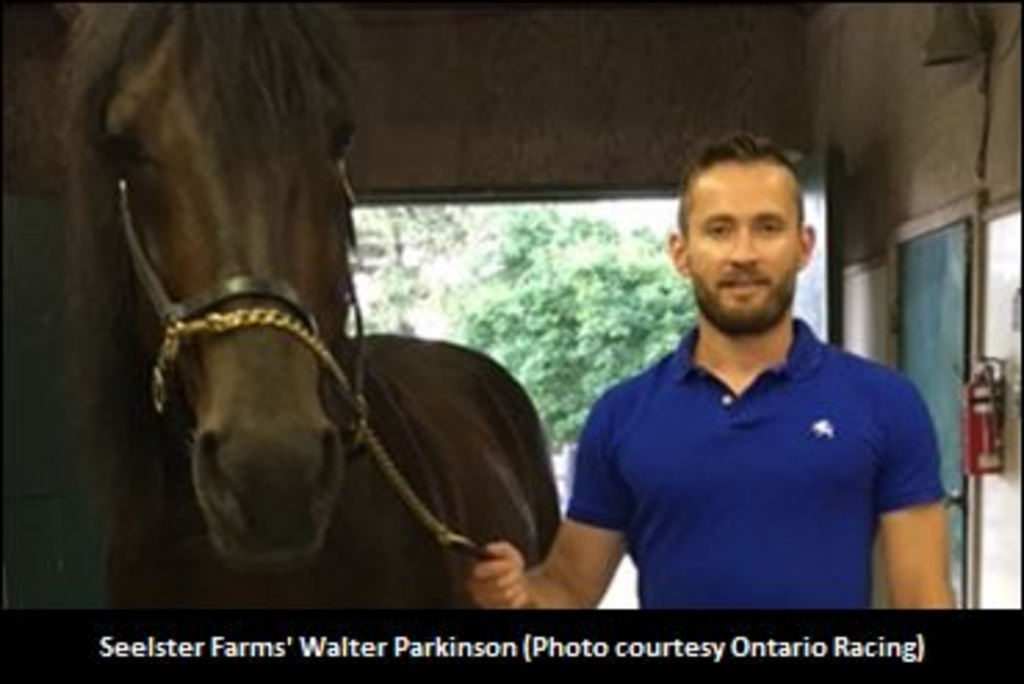
For those looking to breed Standardbreds or buy yearlings this fall, Walter Parkinson said one of the best returns on investment comes from Ontario-sired and Ontario-bred horses.
Parkinson, the president of the Standardbred Breeders of Ontario Association (SBOA) and the Standardbred breeder representative on the board of Ontario Racing (OR), pointed to a number of advantages the province’s Standardbred Improvement Program (SIP) offers horse owners.
First and foremost is the rich and deep Ontario Sires Stakes (OSS) program which offers two tiers, multiple events at the province’s Standardbred tracks and, most importantly, total purses of some $15 million, making it one of the most lucrative sires stakes programs in North America. This year, OR added a third tier, called the 'Prospect Series,' as a pilot project.
On top of that, in 2020 there is just over $3 million available in Standardbred breeders awards.
Ontario-sired Tall Dark Stranger, winning the 2020 Meadowlands Pace
SIP is one of three breed-specific improvement programs that flows out of Ontario’s Horse Improvement Program (HIP) administered by OR. HIP also supports the Thoroughbred Improvement Program (TIP) and the Quarter Horse Racing Industry Development Program (QHRIDP).
While TIP chooses to allocate more funding to Thoroughbred breeders awards, Parkinson stressed the SIP program is driven mostly by the OSS program.
“Certainly in our breed, it goes hand in hand to have the strongest purses you can have and then reward the excellence you can achieve from that. I think it works well for Standardbreds in general, not just the Ontario program. Overall, that’s been the basis of Standardbred breeding, having a strong sires stakes program,” Parkinson said. “I think we're extremely competitive in getting the best stallions available in any given year, along with Pennsylvania, New York and Ohio in some capacity. So I think that's what the sires stakes program does. It gets you top sires in your jurisdiction. And in order to do that, you need to create a program that incents them to come and incents breeders to breed in your jurisdiction to those stallions.”
Ontario-sired Tattoo Artist, taking his life's mark at Woodbine Mohawk Park
This year, Gold purses have typically exceeded $100,000 per race, Grassroots divisions were going for an average of $23,000, and Prospect Series events carried purses of, approximately, $7,000.
“I think the uptake on it has been fairly good,” Parkinson said of the Prospect Series. “It gives people an alternative if they have a nice quality horse that is ready to race, but maybe not quite Grassroots competitive. They have a nice option to race (in the Prospect Series) instead of just an open overnight.”
Parkinson said planning meetings for next year’s OSS events will be held this fall, but he doesn’t anticipate any dramatic changes to the program for 2021 and, likely, the Prospect Series will return.
Though, the COVID-19 global pandemic will have some impact on purses.
“Your home market area wagering is your determining factor for a lot of money in this industry,” Parkinson said of the primary source of SIP funding, which comes from what people physically wager in the Ontario area where they live on Ontario horse racing. With teletheatres and on-track betting windows closed due to the pandemic, that means home market wagering is only coming from those that bet on Ontario horse racing over the internet. Much of the current handle is coming from simulcast wagering from outside of the province. “The sooner (teletheatres and on-track betting windows) can open up, hopefully we can recover a bit from that. I think it's important too to realize everything in the world has been affected. So, people should assume that horse racing is going to be affected to some extent, but it’s not anything specific to horse racing. It’s across the board, worldwide, industry wide.”
One advantage Ontario has over other jurisdictions is a long-term provincial funding agreement in place that provides approximately $100 million annually to the horse racing industry. In many other Standardbred jurisdictions in North America, purses are dependent on casino revenue. Some casinos — such as the non-tribal locations in the state of New York — remain closed, meaning the biggest funding source for purses is temporarily halted in that state and some tracks have plans to end their racing seasons early this year. Not so in Ontario.
As Thoroughbred breeder David Anderson recently told OR, “I think we're fortunate that our purse structure is not focused around casino revenue. With our long-term funding agreement in place [with the province of Ontario], there’s a real sense of security.”
Ontario-sired Beaumond Hanover, taking his life's mark at Woodbine Mohawk Park
Parkinson said Ontario’s program, “remains strong due to the dedication of the funding and the horses themselves. If COVID-19 wasn’t even in the scenario, the quality of the horse is still the same. I think it's an amazing, excellent group of Ontario-sired horses that are going to be sold, wherever they're being sold this fall. We're seeing a great year in the Ontario Sires Stakes program.”
Parkinson said those horses to be sold this fall were the result of mating decisions made long before the COVID-19 pandemic hit.
He also pointed specifically to this year’s three-year-old pacing colt division that features two top colts in Beaumond Hanover and Tattoo Artist that are both undefeated through three OSS Gold Series events in 2020. As well, Ontario-sired Tall Dark Stranger is the leading horse in the division and is the recent Meadowlands Pace and Cane Pace winner.
“There's no question about the quality of horse,” Parkinson said. “If you want to race next summer or in a sires stakes program — or just have an open stakes horse — then this fall is the time to purchase an Ontario Standardbred.”

